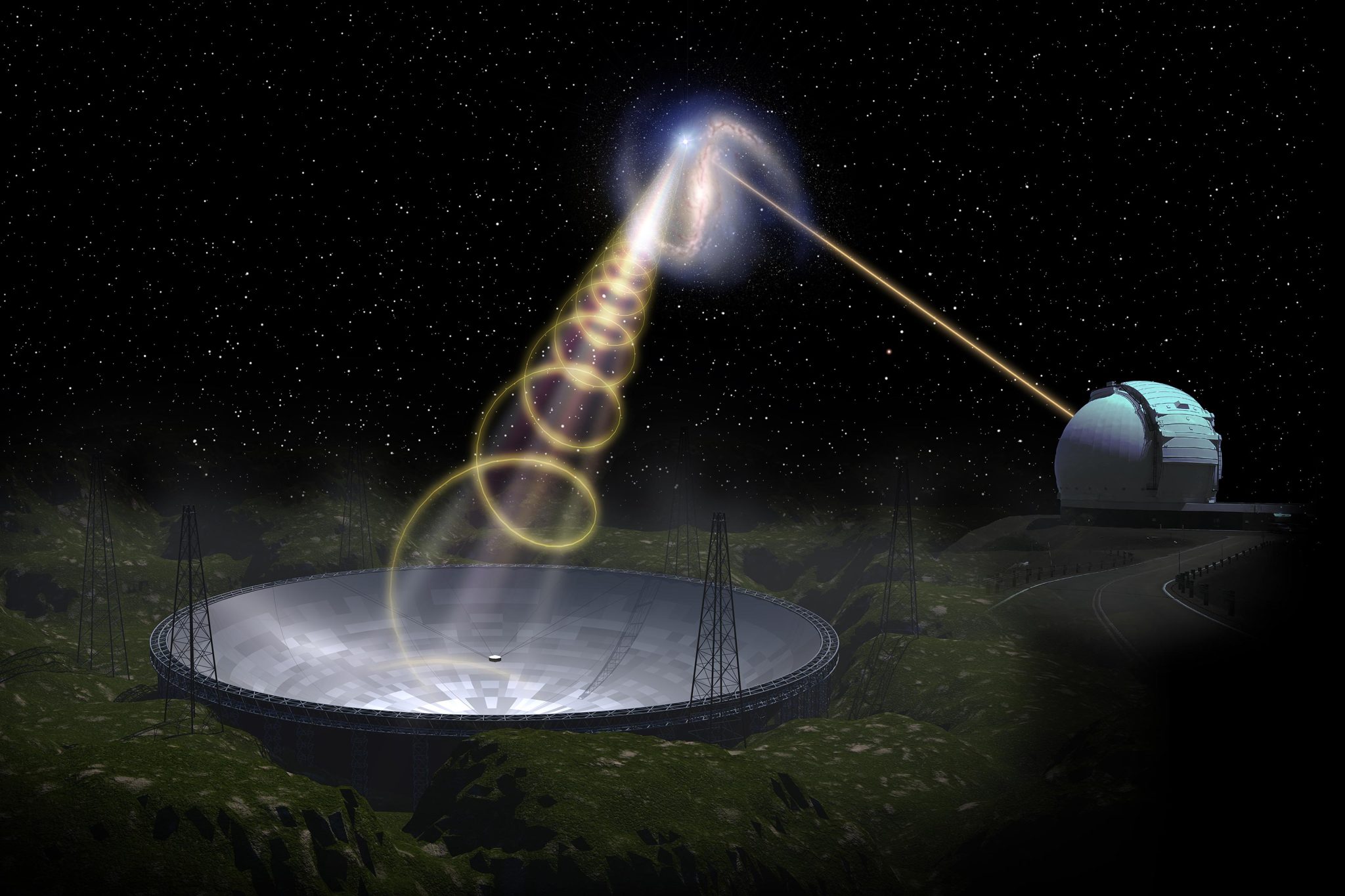
Kunstnerens oppfatning av fem hundre meter Aperture Sfærisk radioteleskop (FAST) i Kina. Kreditt: Jingchuan Yu
Raske radioutbrudd – et gåtefullt og dypere mysterium
Et internasjonalt team av forskere avslører et utviklende, magnetisert miljø og overraskende kildeplassering for raske radioutbrudd – observasjoner som trosser dagens forståelse.
Raske radioutbrudd (FRB) er millisekunder lange kosmiske eksplosjoner som hver produserer energien som tilsvarer solens årlige produksjon. Deres forvirrende natur fortsetter å overraske forskere mer enn 15 år etter at dyprompulsene til elektromagnetiske radiobølger først ble oppdaget. Nå utdyper nypublisert forskning bare mysteriet rundt dem.
Uventede nye observasjoner fra en serie kosmiske radioutbrudd fra et internasjonalt team av forskere utfordrer den rådende forståelsen av den fysiske naturen og sentrale motoren til FRB-er. Forskerne, som inkluderer University of Nevada, Las Vegas (UNLV) astrofysiker Bing Zhang, publiserte funnene sine i 21. september-utgaven av tidsskriftet Natur.
Fem hundre meter Aperture Spherical radio Telescope (FAST) ligger i en naturlig fordypning i landskapet i Guizhou, Kina. Det er verdens største radioteleskop med én tallerken, med en tallerken på 500 meter (1600 fot) i diameter og et mottaksområde som tilsvarer 30 fotballbaner. Det er forventet at FAST vil opprettholde sin verdensklassestatus de neste 20 til 30 årene. Med sitt innovative design har FAST brutt 100-meters tekniske grense for teleskopkonstruksjon og skapt en ny modus for å bygge store radioteleskoper.
De kosmiske FRB-observasjonene ble gjort sent på våren 2021 ved hjelp av det massive fem hundre meter lange Aperture Spherical radioteleskopet (FAST) i Kina. Teamet oppdaget 1 863 utbrudd på 82 timer over 54 dager fra en aktiv rask radioutbruddskilde kalt FRB 20201124A. Forskerne ble ledet av Heng Xu, Kejia Lee, Subo Dong fra Peking University og Weiwei Zhu fra National Astronomical Observatories of China, sammen med Zhang.
“Dette er det største utvalget av FRB-data med polarisasjonsinformasjon fra én enkelt kilde,” sa Lee.
Nylige observasjoner av en rask radioutbrudd fra vår[{” attribute=””>Milky Way galaxy indicate that it originated from a magnetar, which is a dense, city-sized neutron star with an incredibly powerful magnetic field. On the other hand, the origin of very distant cosmological fast radio bursts remains unknown. And these latest observations leave scientists questioning what they thought they knew about them.
“These observations brought us back to the drawing board,” said Zhang, who also serves as founding director of UNLV’s Nevada Center for Astrophysics. “It is clear that FRBs are more mysterious than what we have imagined. More multi-wavelength observational campaigns are needed to further unveil the nature of these objects.”

The Five-hundred-meter Aperture Spherical radio Telescope (FAST), nicknamed Tianyan (“Eye of the Sky/Heaven”) is a radio telescope located in the Dawodang depression, a natural basin in Pingtang County, Guizhou, southwest China. It consists of a fixed 500-meter diameter dish constructed in a natural depression in the landscape. It is the world’s largest filled-aperture radio telescope, and the second-largest single-dish aperture after the sparsely-filled RATAN-600 in Russia.
What makes the latest observations surprising to scientists is the irregular, short-time variations of the so-called “Faraday rotation measure,” essentially the strength of the magnetic field and density of particles in the vicinity of the FRB source. The variations went up and down during the first 36 days of observation and suddenly stopped during the last 18 days before the source quenched.
“I equate it to filming a movie of the surroundings of an FRB source, and our film revealed a complex, dynamically evolving, magnetized environment that was never imagined before,” said Zhang. “Such an environment is not straightforwardly expected for an isolated magnetar. Something else might be in the vicinity of the FRB engine, possibly a binary companion,” added Zhang.
To observe the host galaxy of the FRB, the team of astronomers also made use of the 10-m Keck telescopes located at Mauna Kea in Hawaii. Zhang says that young magnetars are believed to reside in active star-forming regions of a star-forming galaxy, but the optical image of the host galaxy shows that – unexpectedly – it’s a metal-rich barred spiral galaxy like our Milky Way. The FRB location is in a region where there is no significant star-forming activity.
“This location is inconsistent with a young magnetar central engine formed during an extreme explosion such as a long gamma-ray burst or a superluminous supernova, widely speculated progenitors of active FRB engines,” said Dong.
Reference: “A fast radio burst source at a complex magnetized site in a barred galaxy” by H. Xu, J. R. Niu, P. Chen, K. J. Lee, W. W. Zhu, S. Dong, B. Zhang, J. C. Jiang, B. J. Wang, J. W. Xu, C. F. Zhang, H. Fu, A. V. Filippenko, E. W. Peng, D. J. Zhou, Y. K. Zhang, P. Wang, Y. Feng, Y. Li, T. G. Brink, D. Z. Li, W. Lu, Y. P. Yang, R. N. Caballero, C. Cai, M. Z. Chen, Z. G. Dai, S. G. Djorgovski, A. Esamdin, H. Q. Gan, P. Guhathakurta, J. L. Han, L. F. Hao, Y. X. Huang, P. Jiang, C. K. Li, D. Li, H. Li, X. Q. Li, Z. X. Li, Z. Y. Liu, R. Luo, Y. P. Men, C. H. Niu, W. X. Peng, L. Qian, L. M. Song, D. Stern, A. Stockton, J. H. Sun, F. Y. Wang, M. Wang, N. Wang, W. Y. Wang, X. F. Wu, S. Xiao, S. L. Xiong, Y. H. Xu, R. X. Xu, J. Yang, X. Yang, R. Yao, Q. B. Yi, Y. L. Yue, D. J. Yu, W. F. Yu, J. P. Yuan, B. B. Zhang, S. B. Zhang, S. N. Zhang, Y. Zhao, W. K. Zheng, Y. Zhu and J. H. Zou, 21 September 2022, Nature.
DOI: 10.1038/s41586-022-05071-8
The study appeared September 21 in the journal Nature and includes 74 co-authors from 30 institutions. In addition to UNLV, Peking University, and the National Astronomical Observatories of China, collaborating institutions also include Purple Mountain Observatory, Yunnan University, UC Berkeley, Caltech,